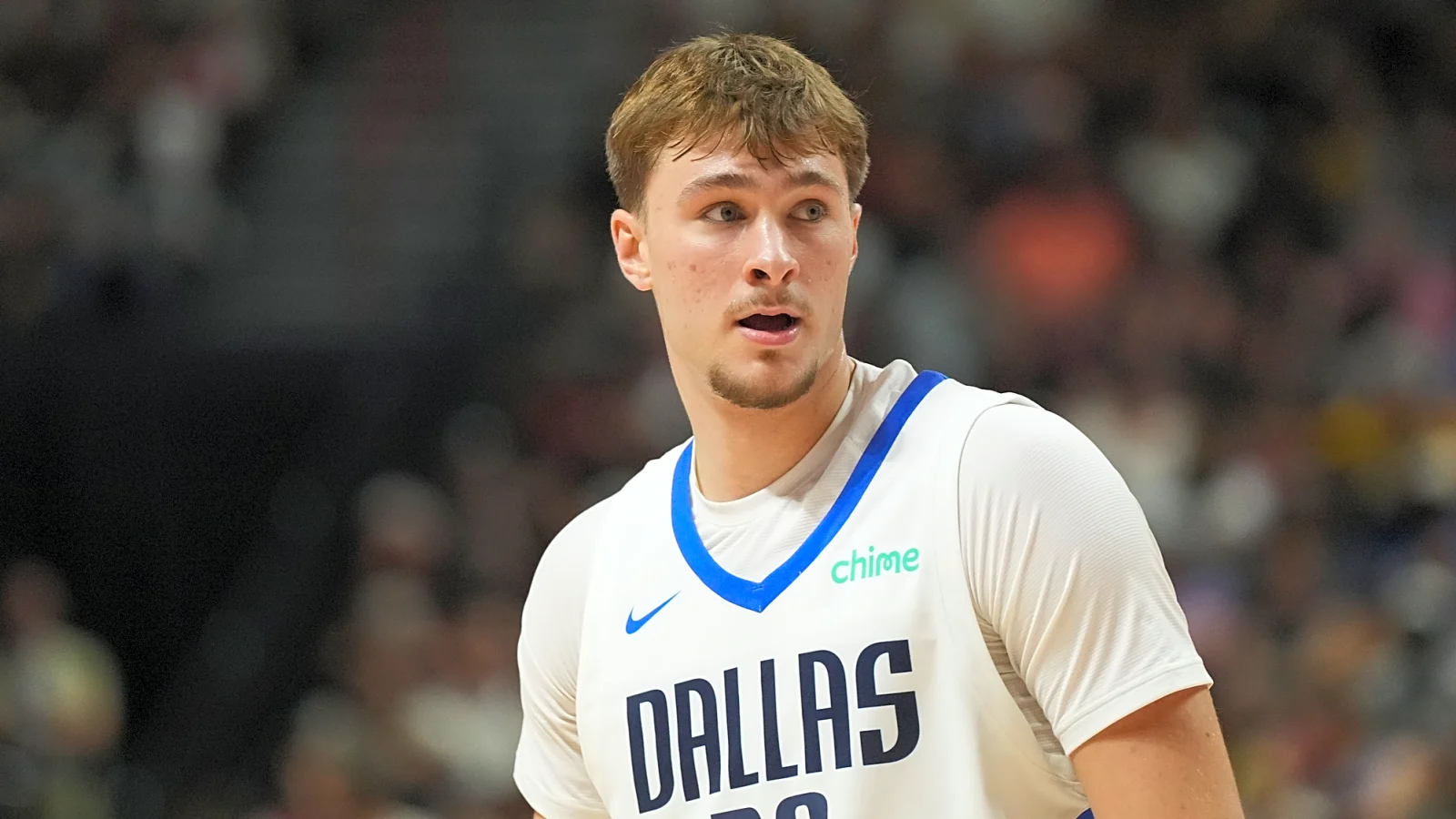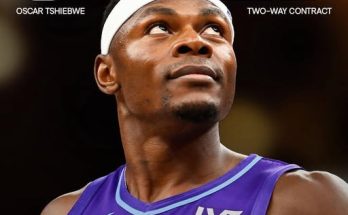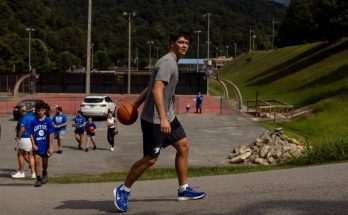Cooper Flagg’s name has been etched into the consciousness of basketball fans for some time, with his dominance at the high school and prep level making him a household name before ever stepping onto an NBA floor. But when he arrived at the Dallas Mavericks’ summer league team and took the court, few could have anticipated just how different he would look. His transformation was not just subtle growth or toned arms. It was dramatic. And for many Mavericks supporters, it was a complete shock.
Flagg, long known for his versatile play, high basketball IQ, and defensive tenacity, had always been a wiry yet effective presence on the court. Even in his high school days, he stood out as someone who could defend multiple positions, handle the ball in transition, and deliver timely shots. He wasn’t flashy in the traditional sense, but his skill set was almost too polished for his age. That’s what made his sudden physical transformation even more jarring. Standing at 6’9”, Flagg had always possessed impressive length. But during his brief hiatus from public exposure prior to joining Dallas, he appeared to have undergone a complete body overhaul. He emerged this summer with broader shoulders, thicker arms, a sturdier frame, and added explosiveness in his step.
Fans online immediately took notice. Social media feeds lit up with comparisons to past NBA players who experienced similar transformations. Some likened it to when Giannis Antetokounmpo entered the league as a scrawny teenager and transformed into a chiseled MVP. Others drew parallels to the rapid growth and muscle development seen in players like Jayson Tatum and Anthony Edwards after their rookie seasons. But what made Flagg’s transformation even more astonishing was the speed at which it occurred. Barely a year had passed since his final run at Montverde Academy, and now he looked like he belonged among the physical elite in the NBA.
What made the situation more compelling for Mavericks supporters was how this transformation seemed to unlock new elements of Flagg’s game. In his debut, he didn’t just hold his own—he controlled the tempo. His improved physicality allowed him to battle effectively in the post, absorb contact when driving to the basket, and hold his ground against veteran summer league players trying to outmuscle him. He attacked with purpose, finishing through defenders and drawing fouls. His movements were more explosive, his lateral quickness sharper, and his ability to finish above the rim had improved markedly. The raw skills were always there, but now his body could keep pace with his basketball mind.
For many Mavericks fans, this change was a hopeful sign that the team may have something truly special on their hands. Dallas has long been searching for a reliable complement to Luka Dončić—a two-way player who can grow alongside their franchise cornerstone. After trying various iterations of co-stars and support players, Cooper Flagg’s development, both physical and technical, looked like the breakthrough they had been waiting for. His ability to stretch the floor, guard four positions, and make high-IQ decisions on both ends is exactly what today’s NBA demands. Add to that a newly developed body capable of handling the grind of 82 games, and suddenly you have a prospect who isn’t just exciting—he’s essential.
The transformation didn’t come out of nowhere, though. According to close sources within the Mavericks’ organization, Flagg’s work ethic had been described as “maniacal.” He arrived in Dallas eager to prove that his hype wasn’t just built on high school highlights and prep accolades. The team reportedly developed a specialized strength and conditioning program tailored to maximize his frame without sacrificing agility or stamina. He worked closely with trainers, spent extra hours in the gym, and focused heavily on nutrition and recovery. For someone so young to take that level of personal accountability spoke volumes about his character and long-term potential. The Mavericks knew they had a mature player from a basketball IQ standpoint, but his dedication to transforming his body reinforced that they also had a professional mindset.
Still, not all reactions were purely celebratory. Some skeptics questioned whether such a rapid physical transformation was sustainable. Would the added weight affect his joints? Would he lose the agility that made him special in the first place? Others worried about the pressure now mounting on a player barely out of his teens. With so much fanfare surrounding his arrival and such a visible change to his body, expectations were ballooning at an almost unreasonable rate. Dallas fans, desperate for the team to return to championship contention, had begun projecting Flagg as a Day One difference-maker. That sort of pressure can be overwhelming, even for the most talented of prospects.
Yet, from every indication, Cooper Flagg remains unfazed. He speaks with the humility and poise of someone who understands the long journey ahead. In interviews, he’s quick to credit his coaches and teammates, and he talks more about team success than individual milestones. His goals are aligned with the franchise’s ambitions: win games, grow into his role, and develop into a leader on and off the court. Mavericks insiders say he’s already begun to take on a mentorship role with other young players, setting an example through his relentless preparation and quiet leadership.
Flagg’s transformation also sends a powerful message about the future of player development in the NBA. No longer is talent enough to guarantee success. In a league that is faster, stronger, and more complex than ever, young players are expected to arrive ready—not just in terms of skill, but in terms of physical and mental conditioning. Flagg’s case demonstrates what can happen when elite talent meets elite preparation. It challenges the traditional timeline of development, suggesting that with the right support, young players can make significant leaps in a short amount of time.
There’s also something symbolic about Flagg’s transformation happening in Dallas. The Mavericks, despite their ups and downs, have often been at the forefront of international scouting and player development. From Dirk Nowitzki’s evolution into a Hall of Famer to Luka Dončić’s rapid ascent, Dallas has shown a willingness to invest deeply in young stars. With Flagg, the organization is once again betting on long-term potential—this time amplified by early, dramatic results. His transformation is not just a testament to his work ethic, but to a franchise that knows how to nurture greatness.
For the fanbase, Flagg represents hope. In a Western Conference filled with powerhouse teams, the Mavericks need more than just Dončić’s brilliance. They need a dynamic core that can compete at both ends, adapt to different styles of play, and carry the torch into the next generation. Flagg’s physical transformation suggests he may be ready to shoulder more of that responsibility than anyone expected. It also redefines his ceiling. He’s no longer just a high-IQ forward with length and defensive prowess. He’s a potential two-way terror who could dominate matchups in ways we haven’t seen from a teenager since the early days of players like Kevin Durant or Paul George.
The buzz around Flagg’s new physique won’t be going away anytime soon, nor will the expectations that accompany it. But that might be exactly how he wants it. For all the hype, all the comparisons, and all the projections, Cooper Flagg seems to prefer to let his game do the talking. And now, with a body that matches his elite talent and mindset, he has the tools to make his case loud and clear. Mavericks supporters may have been surprised by his transformation, but it didn’t take them long to realize what it could mean: the future is arriving faster than anyone thought, and it might just be wearing a Dallas jersey with “Flagg” on the back.



